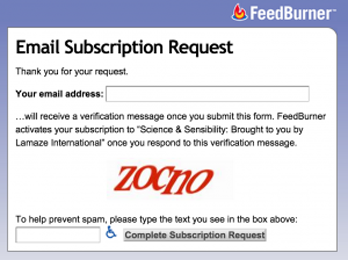January 28, 2015
How to Subscribe to or Follow Science & Sensibility and Your Favorite Blogs
By: Sharon Muza, BS, LCCE, FACCE, CD/BDT(DONA), CLE | 0 Comments
 About 18 months ago I wrote about the six blogs that I thought every childbirth educator and other birth professionals would benefit from reading. It might be time for an updated list or to add a few more of my favorites to the original post. But, before I did that, I wanted to explain how to subscribe to a blog post so you are sure not to miss any good content from those blogs or your favorites.
About 18 months ago I wrote about the six blogs that I thought every childbirth educator and other birth professionals would benefit from reading. It might be time for an updated list or to add a few more of my favorites to the original post. But, before I did that, I wanted to explain how to subscribe to a blog post so you are sure not to miss any good content from those blogs or your favorites.
What does 'subscribe' to a blog mean?
When you subscribe to a blog, you are asking for new posts to be 'pushed' to you when they are published. They can be delivered to you via a blog reader (more on that later) or directly into your inbox. Subscribing means information comes to you, just like a magazine you subscribe to shows up in your mailbox at home or work. You don't have to remember to buy it at the store or read it at the library. It should not cost anything to subscribe to a blog that is available to the public.
What does 'follow' a blog mean?
Following a blog is almost the same thing as subscribing. It seems that people use the term 'follow' when they use a blog reader and subscribe when it comes by email, but really, it is the same thing.
Why should I subscribe or follow a blog?
There are many interesting, useful and informative blogs out there that publish information that is helpful to your profession or that cover topics that you enjoy learning more about. In your internet travels, you no doubt may come across many. You can certainly bookmark the blog urls of your favorites and check back from time to time to see if anything new has been posted. But this is not a very efficient use of your time. And sometimes you forget to come back and check. Why not have the new posts delivered to you at the moment they are published. This way you never miss a post.
Getting updates into your email inbox

Science & Sensibility Subcription
Many blogs will have a subscription box or sign up area somewhere on the blog that requests you enter your email address and you will be signed up to receive new blog posts delivered to your inbox. You may need to confirm your request by replying to the confirmation email sent to you or clicking on the link in that confirmation email. Check your spam and junk folders if this confirmation email does not arrive shortly. Sometimes it could get caught up in your spam filters. Once you confirm your subscription request, you are good to go. Every time your favorite blog publishes something new, you get the content delivered directly to your inbox and you can read it on any device or computer.
Using an RSS Reader
RSS stands for 'Really Simple Syndication' and an RSS Reader just means that you can read all your subscriptions in one place, at one time, whenever you want. The program 'feeds' you the information There are many RSS Readers to choose from, and until it went away, Google Reader was my favorite. Currently, I use Feedly which is one of the most popular, if not the most popular RSS Reader out there and very simple to use. Many RSS Readers are free. I have never paid for one and I am not sure I would, as the free services work just fine for me.
After setting up an account with the RSS Reader of your choice, you then go about telling the service what blogs you want to 'follow.' There is usually an 'add new content' button. You put the url of the blog you want to follow in that box and hit return. Remember to use the main domain of the blog - for example http://scienceandsensibility.org if I wanted to follow this blog. Don't use the url from one particular post.
Sometimes, a blog will have the RSS logo, that makes it easy to subscribe or follow the blog. You click on the symbol, indicate what Reader you are using and it adds it from there. But in general, I tend to copy the url of the blog and enter it myself.
Once subscribed in a reader, you can sort all your 'feeds' or subscriptions into categories. The programs allow you to set up folders that can hold many subscriptions. You might have a category for childbirth topics, and one for recipes and another for your favorite hobby. I tend to just keep them all in one big list (I subscribe to over 400 blogs) and leave it at that. It is your choice.
The reader can show you unread blogs only (i.e., when there is new content) or all the content. Kind of like your inbox can show you unread messages or all the messages. There are other options to toggle on and off, depending on the RSS Reader you are working with. I tend to keep it simple and just have a central list of any new posts from all the blogs I follow as the new ones are released.
Reading on a phone or tablet device
I like to skim my subscriptions or feeds once a day. I tend to do this at the end of the day, in the evening, on my iPad. I enjoy reading the blogs on my tablet, easy to move around and navigate on and easy on the eyes. I use an application called Newsify which is geared for iPods, iPhones and iPads. If you have an another type of device, you will want to find an app that works well on yours. Reading my feeds on my device lets me easily save those I want to keep for reference, and also makes it easy to share with others via email or social media. I can also choose to read offline if I wish. Sometimes I save up a big bunch of unread blog posts to devour on a long airplane flight, when I don't have internet access.
Conclusion
There is a lot of great content coming out all the time that can help you stay on top of news and information professionally as well as for your personal enjoyment. Subscribing to blogs and getting information delivered to your inbox or your RSS Reader is an easy way to have the content come to you, and be ready and waiting when you want to read it. Consider subscribing to your favorite blogs and see how easy it is. Why not try it now with this blog, Science & Sensibility, so you never miss another post! Let us know how it goes, if this whole process is new to you.
Additional resources
How to Subscribe to RSS Feeds
RSS- What is RSS
Tags
Pain Relief Sensibility Professional Resources Doulas Learner Engagement Hands-on Improving teaching skills better birth outcomes childbirth education business Feedly Natural Birth Newsify RSS Readers Specialized childbirth class